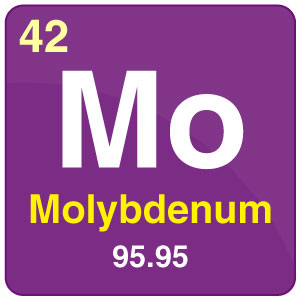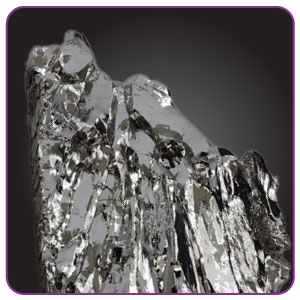Molybdenum

| Symbol | Mo |
| Atomic Number | 42 |
| Atomic Mass | 95.95 |
| Discovered by | Molybdenum was discovered by Carl Wilhelm Scheele |

Chemical Properties of Molybdenum
| Group | 6 | Melting point | 2622°C, 4752°F, 2895 K |
| Period | 5 | Boiling point | 4639°C, 8382°F, 4912 K |
| Block | d | Density (g cm−3) | 10.2 |
| Atomic number | 42 | Relative atomic mass | 95.95 |
| State at 20°C | Solid | Key isotopes | 95Mo, 96Mo, 98Mo |
| Electron configuration | [Kr] 4d5 5s1 | CAS number | 7439-98-7 |
| ChemSpider ID | 22374 | ChemSpider is a free chemical structure database | |
What is Molybdenum?
- Molybdenum (Mo) is a chemical element in the periodic table with atomic number 42, discovered by Carl Wilhelm Scheele in 1778. Its name is derived from the Greek word Molybdos which means lead.
- It is a silvery-white, hard transition metal and has one of the highest melting points of all pure elements.
- It can be attacked slowly by acids.
- Molybdenum is known to have 35 different isotopes varying in atomic mass from 83 to 117.
Uses of Molybdenum
- It is one of the greatest alloying agents as it improves the strength of steel at high temperatures and is applied for use in engines.
- It is even used as a fertilizer for some plants like cauliflower which is known to have Molybdenum deficiency.
- It is used as a catalyst for the petroleum industry.

Comments